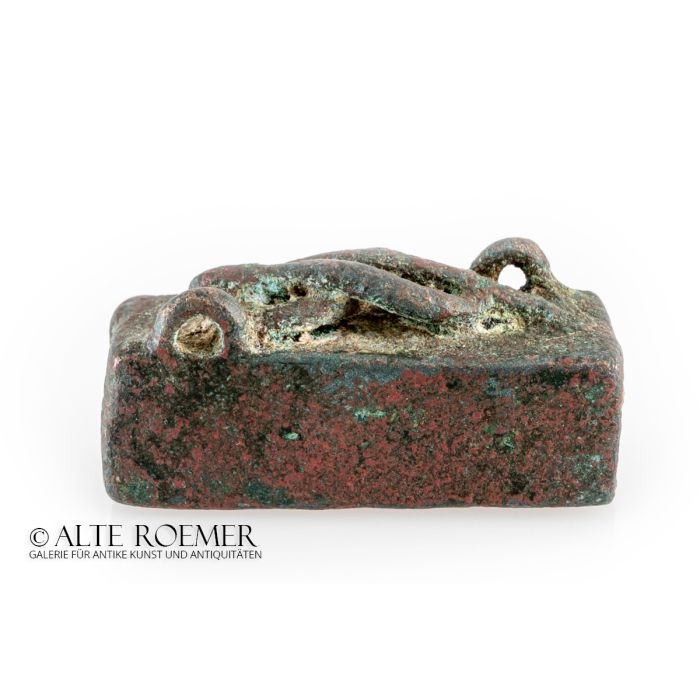Egyptian coffin with snake
Price: on request
Sold
Object number
AR3196
| Object: |
Egyptian coffin for a snake
|
| Material: |
Bronze.
|
| Period: |
Late Period to Ptolemaic rule of Ancient Egypt. 664 BC to 30 BC. |
| Description: |
Egyptian bronze coffin for a snake. Rectangular long box with two suspension loops at the upper rim. Modelled on top with a serpent, coiled up in the shape of an 8 and stretching its head forward. The box was probably made in an ancient workshop in Naukratis, a former Greek trading town in the western Nile Delta. |
| Background: |
This type of box is also called animal relic box or mummy case. And indeed it's primary purpose was to hold animal remains. Animal worship became massively popular in the 1st millennium BC in Egypt. Millions of animals have been mummified and burried from the Late Period to Ptolemaic rule. Small bronze coffins like the piece described above had a opening at the rear side to insert an animal mummy or part of it. The animal shown on the coffin indicates what the box is to contain. In rare cases an inscription was found on the side of the box that states it was devoted to a god. For snake coffins that was a snake god, typically Atum. Boxes from 19th and 20th century excavations have often been opened and emptied. Some never contained animal remains. It is possible that unethical dealers in votive objects scammed their ancient Egyptian customers and sold boxes filled with other materials like stones. It is only since the 21st century that curators and researchers display a strong interest in the contents of such coffins. In 2019 the British Museum x-rayed 8 small relic boxes with intact original seals. Only 3 contained bones with certainty, the contents of the other 5 boxes could not be clearly identified. Some puzzles remain unsolved. |
| Dimensions: |
39mm length.
|
| Condition: |
The narrow side of the box has been broken off and is missing. The rest of the body is intact and in excellent condition.
|
| Provenance: |
Acquired by us in 2021 on the German art market. Previously in the German collection M. G. Acquired into the collection from Galerie Schmidt in Munich, Germany. In Germany since before 1983.
|
| References: |
A series of identical bronze sarcophagi is in the British Museum, for example Museum no. EA49141. The period between 300 and 500 BC is assumed for those pieces. They are believed to be from Naukratis, an ancient Greek trading town in the western Nile delta. The same origin and dating can therefore be concluded for the piece offered by us. See Art Institute of Chicago, ref.nr. 1892.159. For a piece on the art market, see Bonhams London, Antiquities auction 29 Apr 2009, lot 171, sold for 1200 GBP (equivalent to around 1400 EUR at the time). |
| Literature: |
An analysis of Egyptian votive coffins has been made by A. Masson-Berghoff, D. O'Flynn in "Absent, invisible or revealed ‘relics’? X-radiography and CT scanning of Egyptian bronze votive boxes from Naukratis and elsewhere", British Museum Studies in Ancient Egypt and Sudan 24 (2019), p. 159–174.
|
| Authenticity: |
We unconditionally guarantee the authenticity of every artefact, all items are subject to our lifetime return policy on authenticity.
|


